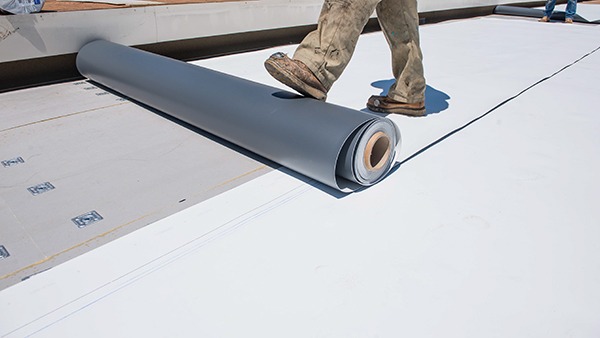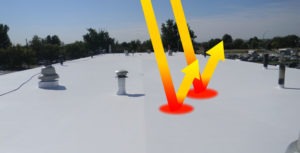
TPO Roofing Systems: The Smart Choice for Commercial Buildings
What Are TPO Roofs?
Thermoplastic Polyolefin (TPO) single-ply roofing systems have become increasingly popular for commercial buildings across the United States. These innovative roofs consist of a single layer of thermoplastic polyolefin, which contains a blend of synthetic rubber, carbon fiber, and fiberglass fillers. This unique composition makes TPO roofs exceptionally flexible, strong, and durable.
TPO roofing was first introduced in the 1990s as an alternative to PVC roofing and has since gained significant market share. The material’s popularity stems from its ability to combine the best features of other roofing materials while offering additional benefits. TPO membranes typically range from 45 to 80 mils in thickness, providing excellent protection against environmental factors and structural movement.
The Advantages of TPO Roofing
TPO roofs offer numerous benefits that make them a top choice for both roofing contractors and building owners:
- Cost-effectiveness: TPO roofing systems are generally more affordable than other single-ply roofing options, offering excellent value for money.
- Easy installation: The lightweight nature of TPO membranes and their wide sheets make installation quicker and less labor-intensive compared to traditional roofing systems.
- Low maintenance requirements: TPO roofs are resistant to dirt accumulation, tears, and punctures, reducing the need for frequent maintenance.
- High energy efficiency: The reflective properties of TPO membranes contribute to significant energy savings in buildings.
- Versatility: TPO can be used on various roof types and is available in different colors to suit aesthetic preferences.
- Resistance to bacteria growth: The chemical composition of TPO inhibits the growth of algae and bacteria, maintaining the roof’s appearance and performance over time.
- Environmental friendliness: TPO membranes are recyclable and do not contain chlorine, making them a more eco-friendly option compared to some other roofing materials.
- UV resistance: TPO roofs have excellent resistance to ultraviolet radiation, helping them maintain their protective properties for longer periods.
Energy Efficiency: A Standout Feature
One of the most remarkable aspects of TPO roofing systems is their energy efficiency. The reflective white topcoat helps keep buildings cooler in summer, reducing cooling costs. In colder climates, darker TPO roofs can help reduce heating expenses by absorbing and retaining heat within the building.
This energy efficiency is not just beneficial for the building owner’s utility bills; it also contributes to reducing the urban heat island effect in densely populated areas. By reflecting sunlight rather than absorbing it, TPO roofs help maintain lower ambient temperatures in cities, contributing to overall energy savings on a larger scale.
Installation Methods and Process
 TPO roofs can be installed using three primary methods:
TPO roofs can be installed using three primary methods:
- Fully adhered: The TPO membrane is bonded directly to the insulation or substrate using a special adhesive. This method provides excellent wind uplift resistance and is often used in areas with high wind speeds.
- Mechanically attached: The TPO membrane is secured to the roof deck using screws and plates. This method is faster to install and can be more cost-effective for large roof areas.
- Ballasted: The TPO membrane is loosely laid and held in place by the weight of river rock, pavers, or other materials. This method is suitable for roofs with adequate load-bearing capacity and offers quick installation.
Regardless of the chosen method, heat-welding at the seams ensures a strong and durable bond. This heat-welding process creates a molecular bond between TPO sheets, resulting in seams that are stronger than the membrane itself.
The installation process involves several key steps:
- Thorough roof preparation: The existing roof surface must be cleaned and cleared of debris. Any damaged areas should be repaired to ensure a smooth, even surface.
- Installing insulation foam: Proper insulation is crucial for the roof’s thermal performance. The thickness and type of insulation depend on the building’s specific requirements and local building codes.
- Laying out TPO material: The TPO membrane is rolled out over the insulation, starting from the roof’s edge. It’s important to allow the material to relax and adjust to the roof temperature before final attachment.
- Securing with fasteners and plates: For mechanically attached systems, the membrane is secured using specially designed fasteners and plates. The number and spacing of fasteners depend on wind uplift requirements.
- Heat-welding seams and joints: A hot-air welder is used to create watertight seams between TPO sheets. This process requires skill and attention to detail to ensure proper bonding.
- Detailing roof penetrations: Special care is taken around roof penetrations such as vents, pipes, and HVAC units. Pre-fabricated accessories are often used to ensure proper sealing.
- Final inspection: Once installation is complete, a thorough inspection is conducted to check for any defects or areas needing additional attention.
Considerations and Potential Drawbacks
 While TPO roofing systems offer numerous advantages, it’s important to be aware of potential drawbacks:
While TPO roofing systems offer numerous advantages, it’s important to be aware of potential drawbacks:
- Regular maintenance is crucial: Although TPO roofs are low-maintenance, they still require regular inspections and upkeep, especially before winter. This includes checking for punctures, cleaning the surface, and ensuring proper drainage.
- Standing water can be a concern: If not properly managed, standing water (ponding) can lead to premature aging of the membrane and potential leaks. Adequate roof slope and drainage systems are essential.
- Proper installation is key: The performance and longevity of a TPO roof heavily depend on the quality of installation. Improper installation can lead to seam failures, leaks, and reduced lifespan.
- Material quality variations: Not all TPO membranes are created equal. The quality can vary between manufacturers and even between different product lines from the same manufacturer. It’s important to choose a reputable brand with a proven track record.
- Potential for shrinkage: Some older or lower-quality TPO membranes have been known to shrink over time, which can stress the seams and attachments. However, advancements in TPO formulations have largely addressed this issue in modern products.
Longevity and Warranty Considerations
The lifespan of a TPO roof can vary depending on factors such as installation quality, environmental conditions, and maintenance. Generally, a well-installed and properly maintained TPO roof can last 20-30 years. Many manufacturers offer warranties ranging from 10 to 30 years, covering both materials and labor.
When considering a TPO roofing system, it’s important to review the warranty terms carefully. Some warranties may require regular inspections and maintenance to remain valid. Additionally, working with a certified installer can often result in extended warranty coverage.
Conclusion: A Reliable Roofing Solution
Despite some limitations, TPO roofing systems continue to evolve and deliver superior performance in various climates. When installed by knowledgeable and skilled roofing contractors and combined with proper maintenance, TPO roofs offer a cost-effective and resilient solution for commercial buildings nationwide.
The combination of durability, energy efficiency, and ease of installation makes TPO an attractive option for many building owners and managers. As the roofing industry continues to innovate, we can expect further improvements in TPO technology, addressing current limitations and enhancing its already impressive performance.
By choosing a TPO roofing system, building owners can enjoy the benefits of a durable, energy-efficient, and low-maintenance roof that stands up to the challenges of modern commercial construction. As with any major building component, it’s crucial to work with experienced professionals who can ensure proper installation and provide guidance on long-term maintenance to maximize the roof’s lifespan and performance.
